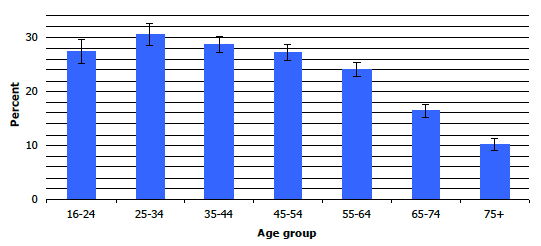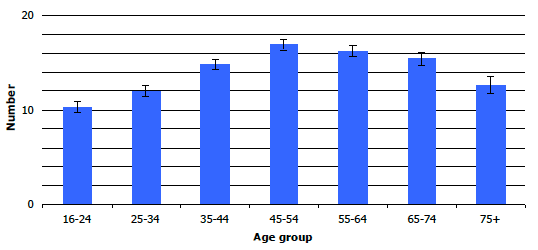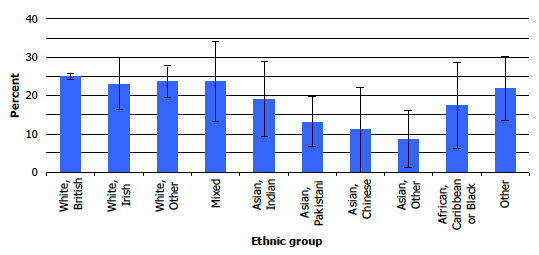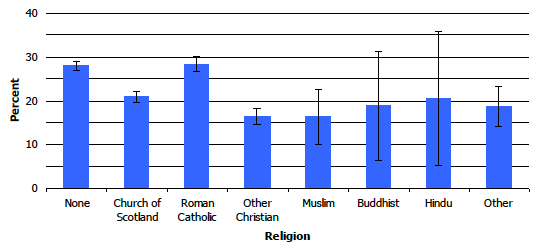Scottish Health Survey - topic report: equality groups
Topic report in the Scottish Health Survey series providing breakdowns of key health behaviours and outcomes by gender, age, ethnic group, religion, disability and sexual orientation.
5 Smoking
Summary
- There was no difference in smoking prevalence between men and women but men smoked more cigarettes per day and started smoking at a younger age.
- Prevalence of smoking was highest among 25-34 year olds and decreased with age but 45-54 year old smokers smoked the most cigarettes per day.
- Pakistani and Asian Other ethnic groups were least likely to smoke.
- Roman Catholics and those who did not belong to any religion were most likely to be smokers whilst Muslims and Other Christians were least likely to smoke.
- Respondents who reported a disability were significantly more likely to smoke than those who did not.
- Smoking prevalence among bisexual, gay and lesbian respondents was not significantly different from that among heterosexuals.
5.1 Measures of smoking
Information about cigarette smoking was collected from adults aged 16 and 17 by means of a self-completion questionnaire which offered them the privacy to answer without disclosing their smoking behaviour in front of other household members. For adults aged 20 and over it was collected as part of the main interview. Those aged 18 and 19, at the interviewers' discretion, could answer the questions either in the self-completion booklet or the main interview.
For young adults, the smoking questions in the self-completion questionnaire focus upon:
- current smoking status
- frequency and pattern of current smoking
- the number of cigarettes smoked by current smokers
- ex-smokers' previous smoking history
- exposure to second-hand smoke.
The self-completion and main interview questions are mostly similar. However the main interview also asked about past smoking behaviour, desire to give-up smoking and medical advice to stop smoking. The question about non-smokers' exposure to second-hand smoke covers a range of domestic and public places, including some locations covered by the 2006 smoking ban (such as pubs).
5.2 Smoking by gender
There was no real difference in smoking prevalence between men and women. The rate for men was slightly higher but the difference wasn't significant (26% compared with 24%). However, men smoked an average of 2 cigarettes per day more than women (15.2 compared with 13.3) and started smoking at a younger age (17.2 years) than women (17.8 years).
5.3 Smoking by age
Age was significantly associated with smoking prevalence and the amount of cigarettes smoked. Prevalence was highest in the 25-34 year old age group (31%) before falling gradually until the age of 55-64 and dropping more dramatically from the age of 65 onwards.
Figure 5A: Prevalence of smoking, by age, 2008-2011 combined

The pattern was somewhat reversed when looking at the average number of cigarettes smoked. 16-24 year-old smokers smoked the least (10.3 cigarettes a day) and smokers between the ages of 45-54 smoked the most (16.9 per day). Levels dropped off among older groups to reach an average of 12.6 among those aged 75 and over.
Figure 5B: Average number of cigarettes smoked per day, by age, 2008-2011 combined

The average age at which people started smoking was 17.5 years. This was broadly similar between the ages of 16 and 64 (ranging between 17.0 and 17.3 years) but increased with age thereafter with 65-74 year olds having started smoking at 18.0 years and the 75+ group starting at age 19.5 on average.
5.4 Smoking by ethnic group
Respondents from Pakistani and Asian Other ethnic groups were significantly less likely to smoke than the national average (prevalence of 13% and 9% respectively). This significant ethnic difference in smoking corroborates with research into smoking and ethnicity in Glasgow.1
Figure 5C: Prevalence of smoking, by ethnic group, 2008-2011 combined

Because of the smaller sample sizes available (as analysis is restricted to current smokers only) it is not possible to provide robust estimates of the mean number of cigarettes smoked by any of the non-white ethnic groups. White British smokers smoked an average of 14.4 cigarettes a day, significantly more than those from Other White ethnic groups (12.1).
The only significant difference between ethnic groups in the age of starting smoking was among the White Other group where respondents started smoking at an average age of 19.3, significantly higher than the national average of 17.5.
5.5 Smoking by religion
There were notable differences in prevalence of smoking by religious faith. 28% of Roman Catholic respondents and respondents who did not belong to any religion were smokers, significantly higher than the national average of 25%. Muslims and Other Christians had the lowest smoking prevalence at 16% and Church of Scotland was also significantly lower than average with 21% smoking within this group.
Figure 5D: Prevalence of smoking, by religion, 2008-2011 combined

Of those who smoked, respondents belonging to no religion, and Church of Scotland, Roman Catholic and other Christian respondents all smoked around 14 cigarettes a day on average. Muslim smokers and those from other religions smoked the least, averaging 8.6 and 11.6 cigarettes a day respectively. There was little difference in the age of starting smoking between different religious groups.
5.6 Smoking by disability
Respondents who reported a disability were significantly more likely to smoke than those who did not. 34% of those with a limiting long-term condition smoked, compared with only 23% and 22% of those with a non-limiting condition or with no condition. Those with a limiting long-term condition also smoked more on average (15.2) than those with a non-limiting condition (14.2) and those with no condition (13.7 cigarettes per day).
Disability was not significantly associated with the age of starting smoking.
5.7 Smoking by sexual orientation
Self-identified bisexual (27%) and gay and lesbian respondents (28%) had a slightly higher smoking prevalence than heterosexuals, but the difference was not significant. Those who self-identified as having an 'other' sexual orientation were significantly more likely to smoke than heterosexual respondents (36% compared to 24%). Those who preferred not to answer the question on sexual orientation also had significantly higher smoking prevalence (33%).
Gay and lesbian smokers smoked significantly more than the national average (17.8 compared with 14.2 cigarettes per day). Bisexual smokers started smoking at 15.9 years old on average, significantly younger than heterosexual smokers (17.5 years).
Contact
Email: Julie Ramsay
There is a problem
Thanks for your feedback